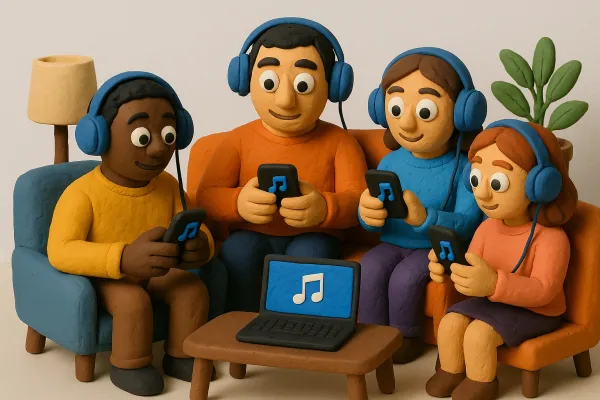Exploring the Rise of Indie Air: A New Wave in Independent Music

Indie Air is shaking up the music world in a big way. It’s more than just a genre—it's a movement that thrives on creativity, authenticity, and independence. Unlike the polished mainstream hits, Indie Air embraces raw, unfiltered sounds that connect deeply with its listeners. This article explores how Indie Air has become a force to reckon with, from its roots to its digital-age explosion, and what the future might hold for this exciting wave of independent music.
Key Takeaways
- Indie Air stands out for its raw and authentic approach, setting it apart from mainstream music.
- Its evolution is deeply tied to technological advancements and changing listener habits.
- Digital platforms have been a game-changer, giving indie artists a global reach.
- The movement challenges traditional music industry norms, paving the way for musicpreneurs.
- Indie Air’s diversity in genres and artists keeps it fresh and appealing to a wide audience.
The Indie Air Phenomenon: What Sets It Apart

Defining Indie Air in Today’s Music Scene
Indie Air isn’t just a genre; it’s a vibe, a movement, and honestly, a breath of fresh air in the music world. It’s where independent artists get to do their thing without the weight of big-label expectations. What makes it stand out is the creative freedom that artists embrace. These musicians often operate outside the mainstream, which means they’re not boxed into formulas or trends. Instead, they experiment, push boundaries, and create music that feels raw and personal.
How Indie Air Differs from Mainstream Sounds
So, what’s the big difference? For starters, Indie Air doesn’t aim to please everyone. It’s not about chart-topping hits or radio-friendly hooks. The sounds are often more intimate, with stripped-down production and lyrics that actually mean something. While mainstream music might feel polished to perfection, Indie Air thrives on imperfections—they’re part of the charm. Think of it as the musical equivalent of a handwritten letter versus a mass-printed flyer.
- Production Style: Minimalist, often self-produced
- Audience Connection: Smaller but deeply loyal fanbases
- Themes: Authentic and often unconventional
The Role of Authenticity in Indie Air
At its heart, Indie Air is all about being real. There’s no pretense, no trying to fit into a mold. Whether the artist is singing about heartbreak, joy, or just the weirdness of life, it’s coming from a genuine place. This authenticity resonates with listeners who are tired of the cookie-cutter approach of mainstream music. It’s why Indie Air has carved out such a strong niche—it feels like a conversation, not a performance.
Indie Air isn’t just music; it’s a connection. It’s the kind of sound that makes you feel like the artist is speaking directly to you, even if you’re just another face in the crowd.
And that’s what makes it so special—it’s not just something you listen to; it’s something you feel.
The Evolution of Indie Air: A Journey Through Time
Tracing the Roots of Indie Music
Alright, so let’s rewind a bit. Indie music wasn’t always the cool, artsy genre we know today. Its roots go way back to the 1970s and 1980s, when bands and artists wanted to break free from the grip of big record labels. They wanted to own their sound, their style, and their vibe. Back then, it was all about DIY—recording tracks in garages, distributing albums at gigs, and hustling to get airtime. This was the era where independence wasn’t just a label; it was a movement. Bands like The Smiths and Sonic Youth made waves by staying true to their art, even if it meant they didn’t hit the mainstream charts right away. This is where the indie spirit was born—pure, raw, and unapologetically authentic.
The 80s and 90s: Indie’s Breakthrough Era
Fast forward to the 80s and 90s, and indie music started to find its footing. This was when "alternative music" became a buzzword. You had bands like R.E.M. and The Replacements in the U.S., and The Stone Roses in the UK, who were carving out a niche. Indie rock was the star of the show, and it wasn’t just about the music—it was a lifestyle. Fans felt like they were part of something underground, something special. The aesthetic was low-budget but high on creativity. The 90s, in particular, were golden, with grunge and Britpop borrowing heavily from indie’s ethos. It was also during this time that indie music started to blur lines with mainstream, as big labels began to notice the potential of these "independent" sounds.
How Technology Shaped Indie Air’s Growth
Now, here’s where things get interesting—technology. The rise of affordable recording equipment and the internet in the late 90s and early 2000s was a game-changer. Suddenly, you didn’t need a fancy studio or a big label to make music. Artists could record tracks at home and share them online. Platforms like MySpace (remember that?) became the breeding ground for indie talent. This shift didn’t just level the playing field—it flipped the whole game. Indie artists could now reach global audiences without leaving their bedrooms. And let’s not forget streaming platforms like Spotify, which made it easier than ever for indie music to thrive. Today, indie air is all about blending that old-school authenticity with the limitless possibilities of modern tech.
Indie music has always been about breaking barriers, and its evolution proves that creativity will always find a way to shine.
The Digital Revolution and Indie Air’s Ascent

Streaming Platforms as Game Changers
Let’s be real—streaming platforms have completely flipped the script for indie artists. Back in the day, getting your music out there meant scraping together cash for studio time, pressing CDs, and begging local radio stations to give you a shot. Now? You can upload a track to Spotify, Apple Music, or Bandcamp, and boom—your music is accessible worldwide. That’s a level of exposure indie artists could only dream of a decade ago.
Here’s the kicker: streaming has also changed how success is measured. It’s not just about album sales anymore. Streams, playlists, and monthly listeners are the new currency.
- Artists can track their audience in real-time.
- They can see which cities are vibing with their music.
- And they can even plan tours based on where their streams are popping off.
It’s like having a built-in analytics team, but without the corporate nonsense.
Social Media’s Role in Amplifying Indie Air
Social media is the ultimate megaphone for independent artists. Platforms like Instagram, TikTok, and Twitter let artists connect directly with their fans. It’s not just about posting music—it’s about sharing the behind-the-scenes stuff, the raw moments, and even the memes. Fans love that unfiltered access.
Let’s not forget TikTok. A single viral clip can turn an unknown artist into a household name overnight. And the best part? Indie artists don’t need massive marketing budgets to make it happen. Creativity and authenticity win every time.
Indie Air thrives on this direct connection. It’s not polished or overly produced—it’s real, and that’s what makes it so magnetic.
The Global Reach of Indie Artists Today
The internet has erased borders for indie music. An artist from a small town can find fans in Tokyo, Berlin, or São Paulo, all thanks to the digital age. Collaborations between artists from different countries are easier than ever, blending genres and cultures in ways we’ve never seen before.
And let’s talk about monetization. With tools like Patreon, merch stores, and even cryptocurrency, indie artists are finding ways to make a living without signing their lives away to a record label. Independent artists monetizing through cryptocurrency is a game-changer, offering direct engagement with fans and a level of autonomy that’s unheard of in the traditional music world.
The digital revolution hasn’t just leveled the playing field—it’s built an entirely new one. And indie artists? They’re owning it.
Indie Air’s Impact on the Music Industry
Challenging Traditional Record Labels
Let’s face it—record labels used to hold all the cards. They decided who got heard and who didn’t. But Indie Air is flipping that script. Independent artists now have the tools and platforms to bypass traditional gatekeepers entirely. They’re creating, distributing, and marketing their music on their own terms. Streaming services and social media have made it possible for artists to build their fanbases without signing away their creative freedom. This shift has forced big labels to rethink their strategies, and it’s about time.
The Rise of Musicpreneurs
Indie Air hasn’t just changed how music is made—it’s changed how artists think about their careers. We’re seeing more “musicpreneurs” than ever before. These are folks who don’t just make music; they treat it like a business. They’re learning how to market themselves, manage their finances, and even book their own tours. It’s inspiring to see artists take control like this. Here’s what sets them apart:
- They adapt quickly to new trends and technologies.
- They’re not afraid to take risks and experiment.
- They value independence over traditional success.
Collaborations Between Indie and Mainstream Artists
One of the coolest things about Indie Air is how it’s blurring the lines between indie and mainstream. Collaborations are popping up everywhere, and they’re bringing fresh energy to the music scene. Think about it: when an indie artist teams up with a big-name star, it’s like mixing two entirely different worlds. The result? Unique tracks that wouldn’t exist otherwise. It’s proof that indie and mainstream don’t have to be rivals—they can actually lift each other up.
Indie Air is more than just a genre or a trend. It’s a movement that’s reshaping the music industry from the ground up. And honestly? We’re here for it.
Exploring the Diversity Within Indie Air
Genres That Define Indie Air
Indie Air isn’t just one thing—it’s a melting pot of genres that somehow all feel like they belong together. From the raw edge of indie rock to the dreamy vibes of bedroom pop, there’s something for everyone. Let’s not forget the ambient electronica that makes you feel like you’re floating, or the acoustic folk tracks that hit you right in the soul. What makes Indie Air stand out is its fearless experimentation. Artists aren’t afraid to blend styles, creating music that feels fresh and deeply personal.
Here are just a few genres that have carved out a home in Indie Air:
- Indie Rock: The backbone of the movement, with bands like Arctic Monkeys and The Strokes leading the way.
- Bedroom Pop: Lo-fi and intimate, it’s like a personal diary set to music.
- Experimental Electronica: Perfect for those who want something a little more out there.
- Folk Revival: A nod to simpler times, but with a modern twist.
Iconic Indie Bands and Solo Artists
When we talk about Indie Air, we can’t ignore the trailblazers who’ve made it what it is today. From bands that defined the early 2000s to solo artists who’ve redefined what it means to go indie, the list is endless. Artists like Phoebe Bridgers and Tame Impala have shown us just how far you can push the boundaries while staying true to your roots.
Here’s a quick look at some of the icons:
| Artist/Band | Known For |
|---|---|
| Phoebe Bridgers | Hauntingly beautiful lyrics |
| Tame Impala | Psychedelic soundscapes |
| Bon Iver | Emotional, layered compositions |
| The 1975 | Genre-bending pop-rock |
The Aesthetic Appeal of Indie Air
Let’s be real—Indie Air isn’t just about the music. It’s a whole vibe. The album covers, the music videos, even the merch—they all scream individuality. There’s a DIY charm to it all, like the artists are inviting you into their world, imperfections and all. It’s raw, it’s real, and it’s relatable.
Indie Air reminds us that music doesn’t have to be polished to be powerful. It’s about the connection, the feeling, and the story behind the sound.
So, whether you’re into the music, the visuals, or the entire culture, Indie Air has a way of pulling you in and making you feel like you’re part of something bigger.
The Future of Indie Air: What Lies Ahead
Emerging Trends in Independent Music
The independent music scene is evolving faster than ever. We're seeing artists embrace unconventional sounds, blending genres we never thought could mix. For example, there's a rise in lo-fi beats paired with classical instruments—it's wild and works surprisingly well. Plus, musicians are leaning into storytelling like never before, crafting albums that feel more like novels than playlists. This shift toward narrative-driven music is reshaping how we connect with songs.
The Role of AI and Technology in Indie Air
AI is changing the game for indie artists. From AI-generated beats to tools that help with mastering tracks, technology is making music production more accessible. Imagine this: you’re an artist with no budget, but now you can create studio-quality tracks from your laptop. Also, platforms are popping up where fans can use AI to collaborate with their favorite indie artists—talk about next-level engagement. But let's be real, balancing tech with authenticity is going to be a challenge.
Sustaining Authenticity in a Commercial World
As indie music gets bigger, staying true to its roots is tough. The more popular an artist gets, the harder it is to keep that raw, unpolished vibe that fans love. It’s a balancing act—how do you grow your audience without losing what made your music special in the first place? A lot of artists are turning to community labels for support. These smaller, DIY record labels help maintain that personal, authentic touch while still offering a path to growth. It’s a win-win for both artists and fans.
The future of Indie Air feels like a tightrope walk—balancing innovation and tradition, growth and authenticity. But if anyone can pull it off, it’s the indie artists who’ve always thrived on doing things their own way.
As we look ahead, the future of Indie Air is bright and full of possibilities. We invite you to join us on this exciting journey! Visit our website to learn more about what’s coming next and how you can be a part of it. Don’t miss out on the latest updates and opportunities!
Wrapping It Up
So, there you have it—Indie Air is more than just a trend; it’s a movement. It’s about artists doing their thing, their way, and finding an audience that gets it. Whether it’s through streaming platforms, social media, or just word of mouth, this new wave of independent music is here to stay. And honestly? That’s pretty exciting. Who knows what’s next, but one thing’s for sure: the indie scene isn’t slowing down anytime soon.
Frequently Asked Questions
What is Indie Air music?
Indie Air is a style of independent music that focuses on original, authentic, and creative sounds. It often avoids the polished or overly commercial vibe of mainstream music.
How is Indie Air different from mainstream music?
Unlike mainstream music, Indie Air emphasizes artistic freedom and authenticity. It often features unique sounds and lyrics that reflect the artist's true vision rather than commercial trends.
What role does technology play in Indie Air?
Technology has been a game-changer for Indie Air. Streaming platforms, social media, and affordable recording tools have made it easier for independent artists to share their music with a global audience.
Who are some famous Indie Air artists?
Some well-known Indie Air artists include bands like Arctic Monkeys and solo performers such as Prateek Kuhad. These artists are celebrated for their unique styles and emotional depth.
Can Indie Air artists collaborate with mainstream musicians?
Yes, collaborations between Indie Air artists and mainstream musicians are becoming more common. These partnerships often bring fresh ideas and expand the reach of Indie Air music.
What’s the future of Indie Air music?
The future of Indie Air looks promising with emerging trends like AI tools for music creation and the growing global audience. However, maintaining authenticity will remain a key challenge.





